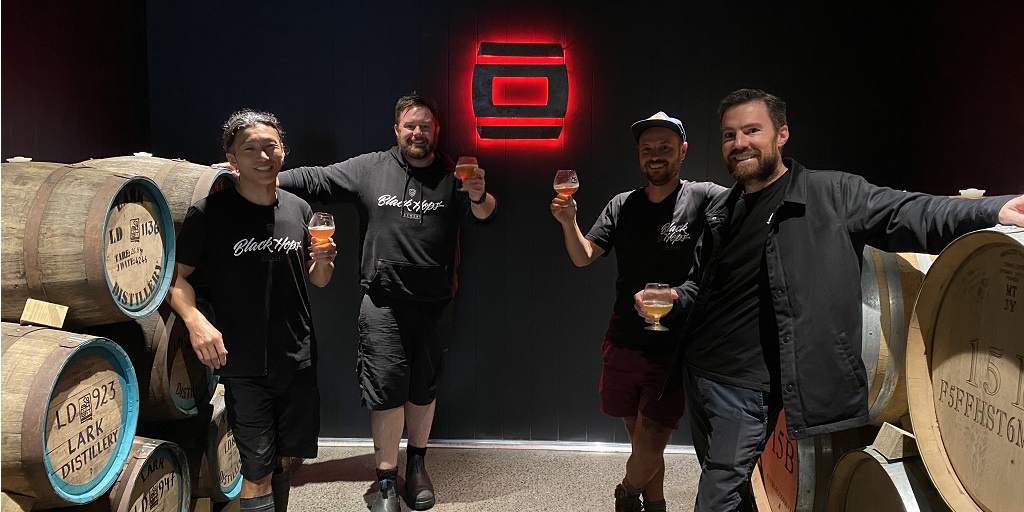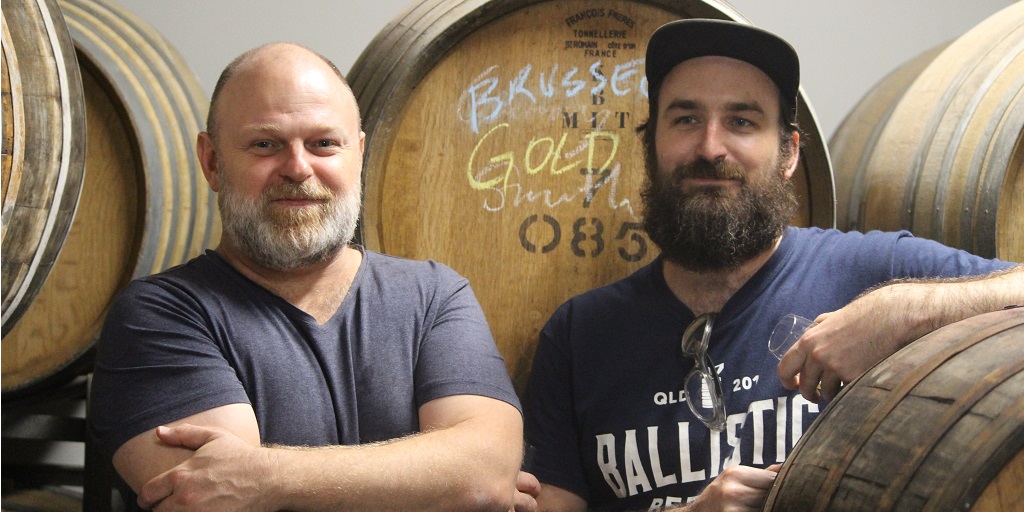
The pains and perks of barrel ageing facilities

Barrel-aged beers can be resource-intensive and low margin, but for brewers who have invested in programs, it is more than worth it.
Queensland breweries Ballistic Beer and Black Hops have in recent weeks launched their own programmes, but they are far from the first. WA-based Rocky Ridge has approximately 300 barrels at any one time, Felons Brewing Co. in Brisbane launched its barrel hall which doubles as a live music venue last year, and Melbourne’s Boatrocker has one of the longest-running programmes, having brought in 60 used wine barrels in 2012 before launching a dedicated facility in 2015, to name but a few. Others such as Wildflower have made it their raison d’être.
At first glance, the relatively low margin barrel-aged beer might not necessarily make commercial sense as determined by the accountants, but the aim of these programmes is not to turn a massive profit, according to brewers who have invested in them.
Matt Houghton co-founder of Boatrocker Brewers & Distillers, which has one of the country’s longest-running programmes, admitted that while margins were tight, there were other, less quantifiable benefits to a barrel ageing programme.
“Barrel ageing beer is certainly more resource-intensive than tank-fermented beer, however, the depth and complexity that can only be achieved this way is enough to justify to us that it is certainly worth it,” Houghton explained.
Similarly, Dan Norris, co-founder of Black Hops, which launched its dedicated barrel-aged beer taproom AWOL last month, said that they were still uncertain of any return on investment.
“We really don’t know if it’s worth investing in to be completely honest,” he admitted.
“It’s just something we wanted to do. Part of the benefits of being independent and majority founder-owned means we can do these things that aren’t necessarily done for commercial reasons.”
Providing both customers and the brewing and marketing team with something new to sink their teeth into was more than worth it, he said, and whether there is customer interest is something they will find out in a few weeks.
“In terms of the price point, our AWOL beers are currently $11 to $16 for a 440ml can so they are quite reasonable.
“If we wanted to optimise for charging more, we would probably just brew a lot of big hazies in small batches, you could do those in a few weeks as opposed to months or years. That’s not what AWOL is about.
“Often we will bring the price down as opposed to up when we feel it’s too high. This is particularly the case with super small batches. It’s amazing how much beer costs when you make 200 litres as opposed to 20,000 litres in a batch.”

Setting up a barrel ageing programme
Barrel ageing can be a drawn-out process, and, if done correctly, requires some very specific conditions.
Black Hops’ Dan Norris said it has been a lot of work, requiring their barrel facility to be located in separate building with custom Foeders cooling pipes, and parts interchangeable with the main brewery to reduce cross-contamination.
“There were quite a lot of changes that had to happen,” he said.
Like Black Hops, Boatrocker started out with a smaller programme using just a few barrels.
“When we first set up in 2012, I built a dedicated cool room to house our 60 barrels, complete with temperature control,” said Matt Houghton.
“We quickly realised that this was not the most convenient space, and as we grew in production of our core beers, we needed a bigger space.”
Boatrocker opened its dedicated barrel ageing facility in 2015 after a lease across the road from the main brewery opened up.
“Temperature control in such a large space [around 3,300 m3] is incredibly costly, so we started out with insulating the roof with the latest closed-cell technology.
“This took two weeks to install, however it keeps the barrel room temperature at an average of 22˚C even in the hotter months. There are extreme days, and so we have now invested in evaporative coolers for the site,” Houghton explained.
Everything down to suitable barrel racking needs to be decided on, and in true brewing industry fashion, a collaborative approach with other industries and a bit of DIY got the job done at Boatrocker. But some elements need a professional third-party approach.
“One of the first pieces of equipment we purchased when we moved into the barrel room was a dedicated barrel steamer. They’re not cheap, but it’s the way with professional niche equipment,” Houghton said.
“I’ve heard crazy stories of people trying to rig up their own steamer using a modified pressure cooker, but not only is that incredibly risky from an OH&S point of view, it will not achieve the temperature required to adequately raise the temperature of the wood nor the moisture level to expand the wood, which is an important factor in imported barrels or older unused ones,” he explained.
Find out more about the Ballistic’s barrel ageing programme on the Beer is a Conversation podcast with Jake Harrison.
Like Boatrocker, Ballistic realised it had to have an entirely separate facility.
“We recognised early that we didn’t want such a program to have close interaction with our existing production facility so began to explore our options for a suitable, nearby location that allowed us to utilise aspects of our existing production brewery in Salisbury, whilst allowing us to efficiently produce these types of beers with a quality-driven focus,” explained Lachy Crothers, head brewer and co-founder at Ballistic Beer Co.
The new site is 1km from its existing Salisbury brewery, and has been designed with some unique features to adapt it to Queensland’s subtropical climate.
“It includes a temperature-controlled barrel room and two 25hL stainless steel fermenters. We produce wort at our existing Salisbury brewery and transport it here for fermentation and barrel filling,” Crothers explained.
“The site provides a lot of flexibility as it enables us to utilise stainless fermentation as well as barrel conditioning. This allows us to brew a broad array of traditional and contemporary mixed fermentation beers.”
Of course each location will be different based on climate and the demands of the barrel ageing programme, but a project like this takes much work, and in an already time-poor industry, the question remains: Is it worth it?
A link to history
It is easy to consider barrel ageing to be a fad in the brewing world, which has seen many come and go, but barrel ageing is a little different according to the brewers who have invested in it.
“After travelling around Europe in my early 20s and sampling these incredible beers for Cantillon and Rodenbach, the impact of wood on beer was etched in my brain in a very positive way,” Houghton explained.
“The character and quality is equal to wine, and arguably a better food match. However, these beers only scratch the surface of barrel-aged beer.”
It’s an interesting characteristic to want to imbue in your beer, given the attempts earlier brewers made to remove the wood flavours and those of any wine or spirits that had been in-barrel before.

Historically, successive soakings of boiling water and hydrochloric acid aimed to remove the wood flavours in new barrels, or they were lined with pitch.Back then, only when the barrel had been classed as ‘neutral’ would it be thought to hold beer.
Now, brewers purposely age their beer in barrels to influence the aroma of the beer, bringing out flavours of oak, or the whiskey, rum or wine that was its previous occupant.
The link to the history of the brewing of beer, while adapted for modern tastes, is part of the attraction of barrel-aged beer.
“Barrel ageing programs are not only a historical link to the ancient traditions of beer in barrels, but they allow the brewer and customer to become emotionally attached to the story, brand and beer by giving them a glimpse and taste into beer’s past,” Houghton said.
“As for the drinking experience of the customer, barrel-aged beer shows nuances and complexities that fine wines would be jealous of, and easily match and many times beat wine on the dining table. So in a nutshell, I wholeheartedly believe they contribute to the experience of visiting a brewery.”
Ballistic’s Lachy Crothers agreed. He said that mixed fermentation and barrel-aged beers occupy a captivating sector of the beer market.
“Their commercial appeal certainly differs from some other styles that are more widely produced.
“We recognise that the current markets for such beers are perhaps less developed, but are also occupied by very passionate, educated consumers who appreciate quality and craftsmanship.”
Ongoing consumer education about these beers, their histories and their unique characteristics is the key to advancing this sector moving forward, Crothers said.
“They are certainly a nice thing to have, for us it’s more about taking those consumers who are really invested in beer or our brand and taking them on a journey with us.
“From a marketing point of view, these beers allow us to offer a more experience-driven value proposition compared to a standard beer of the core range.”
Black Hops’ Dan Norris said that while nothing is compulsory in the world of beer, anything a brewery can do to make their offering more interesting can only be a good thing.
“We’ve always been pretty experimental and I think that’s given us a lot to talk about in our organic marketing, and it’s meant we have a lot of fun things for staff to work on and customers to buy,” he said.
“That experimentation for us I think has been a big part of our success. There are other brands who haven’t experimented too much and have also found their own success in other areas and I’m a big believer in doing what is working for you as opposed to jumping on something because other people are.
“I don’t think AWOL will have much of an impact on the general sales of Black Hops beers, 90% of our sales are our regular beers. But having a program like AWOL has a great indirect benefit across many parts of the business.”
Matt Houghton explained that it was all part of moving modern craft beer away from the mainstream perceptions of beer as a soulless, industrial process.
“Beer can also be a meeting point of art and industry, where blending unique barrels of beer is the remit of the skilled brewer who understands beer in barrels, how those flavours work together, how the previous inhabitant of the barrel will contribute to the end flavour profile of the beer,” Houghton said.
“Sure, we make ‘normal’ beers too, but life is too short to be just ‘normal’… why not rock the boat a little and make something different and delicious?”



